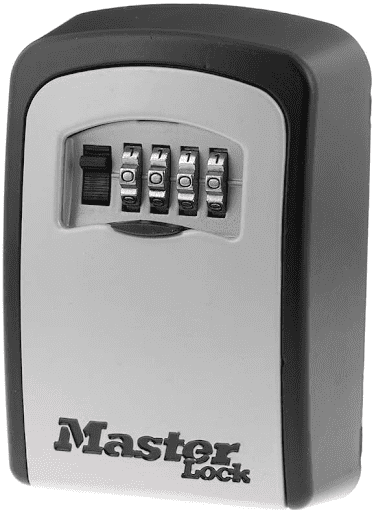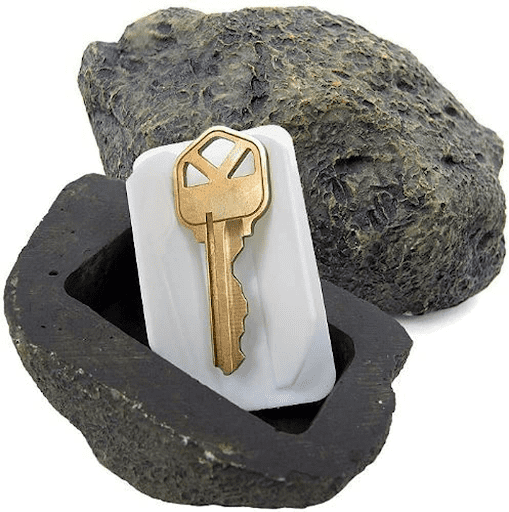We’ve all been there: you step outside for thirty seconds to take out the trash, and suddenly the wind slams your front door shut. You don’t have a key.
It’s in situations like this where you might want to hide a key outside, perhaps under the doormat. This, of course, would be unwise.
To successfully hide a key takes a little thinking outside the box. Burglars and home invaders know every trick in the book—and the very first chapter of that book is ‘under the doormat’.
Find out all you need to know about where to hide a key outside while minimizing the risks posed to home security by keeping your hidden key safe, so that the next time the wind decides to shut you out, you aren’t stranded on the porch.
Places You Should Not Hide a Key
So, you want to hide a key but you’re afraid of intruders discovering it. The most important thing when considering how to hide a key, then, is actually how not to hide it. Let’s discover the unsafe spaces to avoid.
Mailboxes
According to Eagle Operators, the mailbox is a highly suspect place to hide a key, and by far most dangerous. Despite it being one of the least safe options, it remains one of the most popular.
Shockingly, statistics have shown that keys in the mailbox could be responsible for up to 34% of home invasions. That’s over a third of all home invasions. Needless to say, immediately rethink using your mailbox as spare key storage!
Under the doormat
The ancient hidden key doormat routine is another grievous error many homeowners should avoid. The first place a home invader will look for your spare key is under the doormat, or in that rather inconspicuous upside-down flower pot. Yes, gnomes are also a firm ‘no’ when it comes to finding things to hide keys in outside.
Hiding a key under the patio may not be as common as hiding it under the front doormat or in a disused flower pot, but it is still fairly unsafe, since it’s a relatively obvious place which is easy to access.
In fact, the tendency to utilize ‘easy access’ hiding spots likely increases the chances of the key being found.
Recommended reading: Are Fake Security Cameras Worth Buying? Our Top 5 Dummy Security Cameras
Where Should You Hide a Key? Essential Key Hiding Ideas
With that in mind, the question is, where should I hide my key?
Limiting how accessible the key is, even to yourself, will help keep your property safe and the key hidden. Check out these nifty key hiding ideas.
Hidden Key Safe
Hidden key safes are one of the few options for key hiding that actually come with the police’s approval. A number of these devices are available on the market, including on Amazon, which has many inexpensive options.

How does it work?
Key safes are wall mounted. The more inexpensive options are made of a hard plastic, and feature a four number code lock. You can only open the box and retrieve the key with the correct code.
Why we recommend it
Though it might be a little inconvenient for you, the fact that key safes are usually wall mounted means you could place it as high up a wall as you like. The likelihood of a burglar bothering to reach it is then rather low, since it is noisy and attracts attention.
They are also very small devices, making them much more subtle than a regular locked safe and significantly more conspicuous than a doormat.
Birdhouse
Speaking of height, an unconventional but easy way to achieve this is by using a birdhouse. Again, Amazon has plenty of affordable options (just make sure you go for an authentic looking one).
How does it work?
If your property has any tall trees, place the birdhouse inside the tree, or otherwise nail it high up on the trunk. You could also place it on a shed, or by a standalone birdhouse with a pole. Rather than placing feed inside, place your key in the hole and insert either a cloth, a piece of card, or some other material to cover it up.
Why we recommend it
Even if it occurs to a burglar to check, it’s unlikely they will if it isn’t easy to reach. Generating noise and attention is exactly what a burglar wants to avoid, after all. That’s why it’s best to opt for a conventional birdhouse that requires nailing to a surface, rather than one on a pole.
Consider having a security camera observe it for additional caution. Pointing an old phone with AlfredCamera through a window is an easy way to have an extra pair of eyes on spare keys, wherever you choose to hide them. See our home security camera placement guide.
Just make sure you also have a means of reaching the birdhouse, whether that’s an old ladder hidden round the back of the property or a childhood spent climbing trees!
In Soil
While turning a disused plant pot upside down with your key beneath it is just begging to be picked up by a burglar, burying your key in the soil of an actual plant or plant bed might be a pretty ingenious (albeit messy) way to conceal a key in plain sight.

How does it work?
If the front garden has a plant bed with soil, try seeing just how far down the soil goes. If it is a deep bed of several inches, you could push the key through it. Likewise, any deep potted plants you have in the yard could be used in a similar way. For the sake of hygiene (and avoiding a rusted key), you could put the key in a small box before inserting it into the soil. This should also help reduce the chance of losing it.
Why we recommend it
Occasionally, hiding a key in plain sight can be virtually impossible to spot, as is the case here. So long as the key is pushed deep enough into the soil, it won’t be at all visible to anyone passing by.
Hence, you must first make sure the bed is at least double the length of the key itself. You should also attempt to insert the key horizontally so it can lay flat far beneath the surface. This will make it less likely to poke out following bad weather.
The main risk with this approach is that you could lose the key if you aren’t aware of exactly where you’re putting it. Still, if it’s too close to the surface, just a little wind and rain could expose it, putting your security at risk.
Hide-A-Key Objects
Realistic looking objects, from faucets to dog excrement, are a fairly common means of hiding a key. One of the best hide a keys is a garden rock or pebble. Instead of buying one online, you can also follow our step-by-step guide to make your own hide-a-key object (fairly simple)!

How does it work?
The best hide a keys will be made from a durable type of plastic. These objects are weather-proof, so you can use them all year round. The small ones can comfortably keep keys that are no longer than 2.9 inches in length and 1 inch in width, so don’t attach keyrings.
Why we recommend it
Reddit users recommend using a key hider to safely keep an emergency key. Hide a key objects are very inexpensive, and when concealed properly can prove to be pretty useful.
Though it’s tempting to buy online, we’d advise checking out the product you’re interested in in real life first, since it can be hard to tell just how realistic looking it is from a promotional image found on the web. Hardware stores like Home Depot are worth checking out for realistic objects.

After all, its success depends on how well it fits in with your surroundings. If the fake rock you choose is a completely different color to the rocks you have elsewhere in your front yard, it’ll be a dead giveaway that there’s something inside it. Likewise, having the object somewhere ‘deep’ within the outside of the property (like up a tree or in the back garden) is best if space permits it.
For a more unconventional approach, a hide-a-key dog poo might be a fun option—and one that’s guaranteed to keep burglars far away. Again, realism is the key to success here (no pun intended), and this option from the one-stop-fun-shop achieves just that.
Keep Your Hidden Keys Safe with Security Cameras
Regardless of where exactly you opt to hide your key, it pays to be realistic about the risks this can pose. By having a key anywhere outside of your property and not on your person, there is always going to be a risk that it is found and used to initiate a home invasion.
That’s why having some kind of home surveillance is a logical next step to ensuring the safety and security of your property.

Recommended reading: Porch Pirates: 5 Ways To Stop It From Happening To You
AlfredCamera is one such option. By turning your old phone into a fully-functioning security camera, you are able to have another pair of eyes and ears watching over your spare key and your front door.
If someone starts snooping around the stones on the porch, AlfredCamera can immediately alert you through push notifications. Did we mention it’s free?
Download now for iOS and Android devices, and start protecting your home today.
Recommended reading: Bad Neighborhoods: What Are Your Safety And Security Options?
FAQ
How do I identify the area to put a key-hiding device?
The best place to put a hide-a-key device is in an area that allows it to mimic a natural setting. For instance, you should place the hide-a-key rock amongst other rocks outside of your home. Only choose an item that looks realistic in context. If a garden gnome sticks out like a sore thumb against your ultra-modern front door, don’t use it.
Does it make sense to use multiple key-hiding devices?
According to experts, it will be more convenient for you to use one key-hiding device at a time. Having multiple devices scattered around your home can quickly begin to confuse family members. Not to mention, the more of them there are, the more likely they will draw attention to themselves, especially if they are all wall mounted.
Where do burglars look for keys?
Common places that burglars look for keys include mailboxes, doormats, and flower pots. Also avoid putting your key under your patio furniture or under the garbage bin. As a rule of thumb, avoid places that are close to the ground – the higher up the key is positioned, the more likely the home invader will be deterred, even if it seems fairly obvious to them where it is. Attracting attention is never going to be the aim of a burglar, so if a spare key requires five years of elite gymnastics to even attempt to reach it, they probably won’t bother.
Conclusion
There are clearly quite a few options when it comes to making decisions on how to hide a key outside your home. That’s why it’s best if everyone living in the property is well aware of where the key will be, as this will help prevent confusion and ultimately reduce the risks associated with it.
We also suggest you compliment your key-hiders with other security features. Surveillance cameras, like AlfredCamera, and alarms can act as additional deterrences and allow you to improve your home’s security.
Hiding a spare key is never going to be a failsafe, 100% secure endeavor, no matter how ingenious a technique you decide upon. If you can avoid it altogether, do so.
That being said, there are several smart ways you can make your home more secure, especially when you travel out of town, and mounting security gadgets can greatly reduce the risks associated with hiding spare keys.
Recommended reading: How to Hide AlfredCamera: 10 Clever Tips
